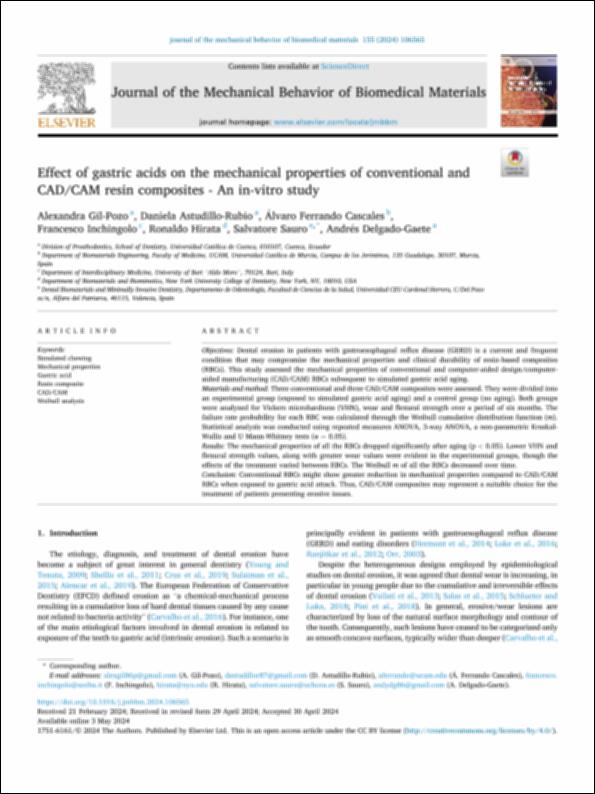Por favor, use este identificador para citar o enlazar este ítem:
http://hdl.handle.net/10637/15888Effect of gastric acids on the mechanical properties of conventional and CAD/CAM resin composites : an in-vitro study
| Título : | Effect of gastric acids on the mechanical properties of conventional and CAD/CAM resin composites : an in-vitro study |
| Autor : | Gil Pozo, Alexandra Astudillo Rubio, Daniela Ferrando Cascales, Álvaro Inchingolo, Francesco Hirata, Ronaldo Sauro, Salvatore. Delgado Gaete, Andrés |
| Materias: | Material compuesto; Composite materials; Diseño por ordenador; Computer aided design; Odontología; Dentistry |
| Editorial : | Elsevier |
| Citación : | Gil-Pozo, A., Astudillo-Rubio, D., Ferrando Cascales, Á., Inchingolo, F., Hirata, R., Sauro, S. & Delgado-Gaete, A. (2024). Effect of gastric acids on the mechanical properties of conventional and CAD/CAM resin composites : an in-vitro study. Journal of the Mechanical Behavior of Biomedical Materials, vol. 155 (jul.), art. 106565. DOI: https://doi.org/10.1016/j.jmbbm.2024.106565 |
| Resumen : | Objectives: Dental erosion in patients with gastroesophageal reflux disease (GERD) is a current and frequent condition that may compromise the mechanical properties and clinical durability of resin-based composites (RBCs). This study assessed the mechanical properties of conventional and computer-aided design/computer-aided manufacturing (CAD/CAM) RBCs subsequent to simulated gastric acid aging. Materials and method: Three conventional and three CAD/CAM composites were assessed. They were divided into an experimental group (exposed to simulated gastric acid aging) and a control group (no aging). Both groups were analyzed for Vickers microhardness (VHN), wear and flexural strength over a period of six months. The failure rate probability for each RBC was calculated through the Weibull cumulative distribution function (m). Statistical analysis was conducted using repeated measures ANOVA, 3-way ANOVA, a non-parametric Kruskal-Wallis and U Mann-Whitney tests (α = 0.05). Results: The mechanical properties of all the RBCs dropped significantly after aging (p < 0.05). Lower VHN and flexural strength values, along with greater wear values were evident in the experimental groups, though the effects of the treatment varied between RBCs. The Weibull m of all the RBCs decreased over time. Conclusion: Conventional RBCs might show greater reduction in mechanical properties compared to CAD/CAM RBCs when exposed to gastric acid attack. Thus, CAD/CAM composites may represent a suitable choice for the treatment of patients presenting erosive issues. |
| URI : | http://hdl.handle.net/10637/15888 |
| Derechos: | http://creativecommons.org/licenses/by/4.0/deed.es Open Access |
| ISSN : | 1751-6161 1878-0180 (Electrónico) |
| Cubierto por: | Acuerdo Transformativo – 2024 |
| Fecha de publicación : | jul-2024 |
| Centro : | Universidad Cardenal Herrera-CEU |
| Aparece en las colecciones: | Dpto. Odontología |
Los ítems de DSpace están protegidos por copyright, con todos los derechos reservados, a menos que se indique lo contrario.


